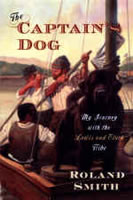|
|
|
|
|
HOMEReading Questions for
|
Lewis & Clark Resources: Discussion QuestionsThe Captain's Dog: My Journey with the Lewis and Clark Tribe, By Roland SmithBook Description for The Captain's DogDiscussion Questions for The Captain's Dog Links to Information About the Author Lesson Plans for The Captain's Dog 
Book Description from back cover:Born the runt of the litter and gambled away to a rusty old riverman, the Newfoundland pup Seaman doesn't imagine his life will be marked by any kind of glory - beyond chasing down rats. But when he meets Captain Meriweather Lewis, Seaman finds himself on a path that will make history. Lewis, with a commission from President Thomas Jefferson in his pocket, is just setting off on his landmark expedition to chart the best path across America to the Pacific Ocean, and they take Seaman along. Part history, part science - and adventure through and through - The Captain's Dog is the carefully researched, thrilling tale of America's greatest journey of discovery. Book Discussion Questions for The Captain's Dog:Questions written by Aurora Grey 1) Why has President Thomas Jefferson sent Captains Lewis and Clark to find "the long
-sought-after Northwest Passage"? Today it is easy to travel from the Atlantic Ocean on the
East Coast of the United States to the Pacific Ocean on the West Coast. Why was it so
difficult to travel across country by land to reach the Pacific Ocean in Lewis and Clark's
time?
2) Why does Captain Lewis want a dog to take along? How could having a dog help him and the other explorers on the journey from Pennsylvania to the Pacific Ocean? Why would he want a Newfoundland in particular? 3) How does telling about Lewis and Clark's journey from the point of view of Lewis' Newfoundland dog Seaman affect the story? Do you think Seaman sees things that another observer might not? Do you think you learn more about the plants and animals in the world Lewis and Clark traveled through because of seeing the trip through Seaman's eyes? 4) Lewis and Clark, and some other members of their expedition, were responsible for keeping official journals with detailed records of the expedition. Why might Meriweather Lewis keep a personal journal? What might we be able to learn from his personal journal that would be different from the records in the official journals? 5) In addition to searching for the Northwest Passage, Lewis and Clark were sent to open up negotiations between the many Native American tribes and the United States government. What do you think of the speech that Captain Lewis gives several times in the book when the explorers meet to parley (an old word meaning either "to speak with" or "a conference for discussing points of dispute) with the various Native Americans? What do you think it shows about his attitude toward the Native Americans? Do you think he shows prejudices toward the Native Americans during negotiations and trading? 6) How do the Native Americans react to Lewis' speech? How do they react to th trade gifts of American flags and medals that the explorers bring? What do these items represent to the explorers? What do they represent to the Native Americans? 7) What are trading negotiations like between the explorers and the Native Americans they meet? The explorers meet with people from many different tribes, and each interaction is different. How do these interactions differ? How are they similar? Why do you think this is so? Why do you think disputes arise between the explorers and the Native Americans over trades that are made? 8) How do the Native Americans they meet help the explorers? What knowledge do some of the tribes they meet have that they need to complete their journey? 9) What dangers do the explorers face? Do you think that going on an expedition like the one Lewis and Clark went on would be exciting or scary? Do you think that the chance to travel to new places, through unknown territory, would be worth the hardships the explorers suffered? 10) Why do you think that some of the members of the expedition choose to stay out West, becoming trappers and traders, while others (including Lewis and Clark) choose to return to the cities in the East? 11) Historical fiction takes historical events and historical settings, and creates stories about what might have happened in the past. Authors research the settings and types of people they are writing about. Some, like The Captain's Dog, follow the course of real events and the lives of real people based on what we know about them from historical documents, and fill in the story around what we know from those records. The Captain's Dog uses entries from Lewis' actual journals and draws information about the expedition from the detailed journals that were kept by members of the expedition. Others tell fictional stories in historical settings (authors may still do plenty of research on what people were like, what they did, what they wore, what they ate, and so forth for this second type of historical fiction novel). Compare what you read in The Captain's Dog with what you have read in your social studies book about Lewis and Clark's expedition. What sort of things that are not in your textbook does The Captain's Dog include that might help you to understand Lewis and Clark's journey better? Back to Top
Related Websites:Links to Information About the Author:
Back to TopLesson Plans for The Captain's Dog
Back to Top |